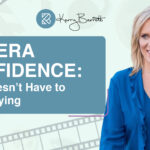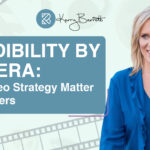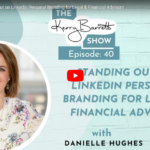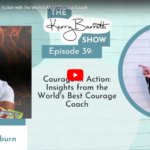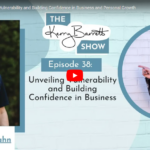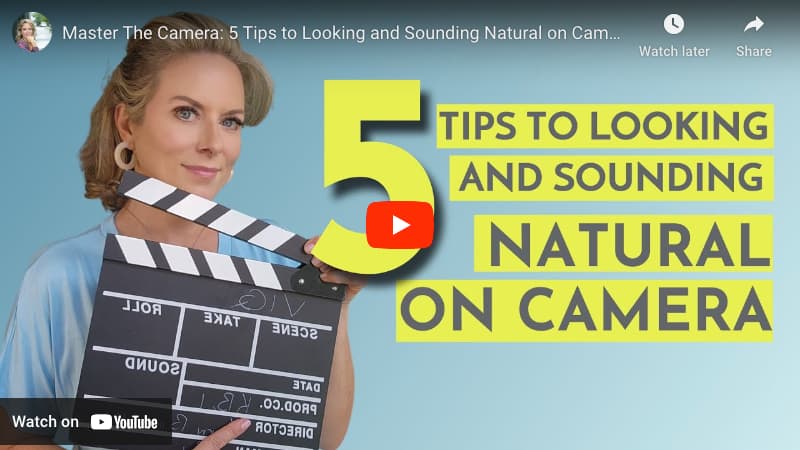
Have you ever spent more time than you should have on many takes for a single video? We always want our content to look perfect and sound perfect, but that instinct might not always be the right one. When it comes to creating video content for marketing, especially on social media, “refined” is the direct opposite of “natural” and might even be counterproductive for what you intend. If you want your audience to connect with you and be entertained, these are a few tips you should keep in mind!
Transcript
Kerry Barrett 01:44:29
If you’ve posted any sort of video content for your business, if you’re like most people, you probably spent a very long time writing a script. Maybe you memorized it, you got all dressed up and you looked and sounded as perfect as you could. Unfortunately, that sort of content doesn’t necessarily resonate. When you’re posting marketing videos, people want to be inspired, and edutainment by video at the top of your funnel, meaning they want to connect with you. And they also want to learn something for you. The Sound stilted looking perfect. And dressing up isn’t going to work for you. Now, I spent a very long time as a news anchor, trying to be perfect, perfect, perfect. And it’s only when I broke out of that. And I discovered how to become relatable and authentic, that I was able to make real strides. This same applies to you, as a business owner creating video content or showing up on camera or on video. You don’t have to do all of those things. But there are five key ways that you can look and sound more natural and more comfortable on camera. And that is what we’re going to dive into today. The first is to sort of be who you are. Now, if you look back at video of me, when I first started my business however, many years ago, you will often see video of me here in this office or wherever I was dressed to the nine I was in my news anchor attire and it didn’t really look like I fit in, in my own home. Here I am sitting on my couch with my dogs and my kids and my cats and I’m dressed to the nines. So what I had to figure out is Who am I talking to meeting that audience exactly where they are. And then using those visual cues, my clothing connects with them. So now I’m in a T-shirt, and I am in shorts. You may not see me from head to toe in every single video. But I’m dressed in a way that makes me feel comfortable. And makes me meet my audience wherever they are. That will vary depending on who you are, who your audience is and where you’re shooting. But the key is, wear something that you feel comfortable in. And you also feel confident in. The second thing is to know what you sound like. And what I mean, what you sound like is what you sound like when you’re talking to someone that you are comfortable with. One of the dead giveaways that somebody doesn’t feel comfortable on camera is the fact that they’re saying words in a monotone kind of way. So think about how you would talk to somebody who you know, really, really well. And it may be that you have to put a little bit of moderation on that speech or that content or that video, because perhaps you’re using words that you wouldn’t use with a business audience. But think about the way that you sound and the way that you connect and the way that you talk to somebody that you know, really well. And then replicate that on your video or on camera. If you don’t know what that is. If you’ve never watched yourself to understand the way that you speak the cadence, the mannerisms that you use very naturally videotape yourself. Now I recognize you’re thinking, Okay, well, now I’m recording myself and I know that I’m recording myself. So doesn’t that diminish any of the gains that I’m looking to make? It does to a certain degree, but you should think about doing is setting up a video or a camera in sort of a remote corner of your room and then having a lengthy conversation, that in fact, you could just record your day on that call your zoom calls, your regular phone calls or conversations that you have with your husband, your kids, and then go back and watch and see what you sound like and what you look like when you’re communicating with somebody that you know very well and you feel very comfortable with, then you want to take that and you want to amp it up a tiny bit for your on camera delivery. If you have questions about how to amp it up and how to increase that energy, you can check out this video right here. The next element is understanding that you are speaking to one person and this may not necessarily make you feel comfortable because it is removing some of that filler in that fluff that we tend to use. But it does make you look comfortable and confident to your audience. So I talked about all the time how even if there’s a million people watching your video, you always have an audience of one yet, countless times. You go onto a live stream and you hear people say hey everybody or Hi youtube or what’s up IG how’s it going tick tock whatever the case may be and it’s very clear that they are talking to an audience. Think about how you would talk to somebody if they Were sitting right in front of you, if they were in this space right here, you wouldn’t say to them hi IG or what’s up LinkedIn live, you would say, You How are you, it’s good to see you are just plain old. Hi. So remove the everybody, you’ve removed the Instagram, remove the phrases and terminology that you wouldn’t use when you’re talking to somebody in person. And think about using any derivative of the word you, you yours yourself, I guess I said, use one of those forms of the word you in the first five seconds of your video, and you will look and connect with the person who’s watching much more quickly. And they will know that this video was made for them. The fourth thing is knowing your body language, knowing how it is that you talk to somebody that you know quite well. And you can use the same technique that we talked about and understanding the cadence of your voice to discover your natural body language as well. And so there’s a couple of different things that I do when I’m looking to make sure that I’m connecting with whoever’s on the other side of the screen. In this case, it’s you. I like to stand up if I’m doing a lot of content all at once, standing up helps me boost my energy, which by the way, is one of the biggest mistakes we will make they do not have enough energy in their videos. If you’re looking to figure out how to overcome that, you can check out the biggest mistake people make on video right here and learn some techniques for it. But standing up is one of the ways to eliminate that energy drain when you are creating content. The other thing is to make sure that you are talking to the audience in this case in the way that you would naturally. So it doesn’t mean that you are super close up and in their space, it doesn’t mean that you are four ways that your mic sounds bad and you can’t look in my eyes. What it does mean is that you are framed well, that you are using the same techniques that you would use in a conversation in terms of your body language you are leaning in, you are using your hands, you are using your facial expressions. If you’re curious about how to amplify your natural body language for video, you can check out this video right here. Now one of the weird things that works is making sure that your hands are showing. And once you get in your head about these different little elements of
communicating on camera, it is all sort of lost. You’re you’re you’re thinking about what you’re supposed to say and also how you’re saying it, the key is to bring those two things together. But when you are framing yourself up, make sure that your audience can see your hands. Palms up is a very welcoming gesture. And it brings your audience in another Weird But True thing that works. Your audience wants to see your thumbs for some reason, it makes them feel more connected to Weird But True. Here’s my thumbs. And then finally, sounding natural. Now there’s a couple of ways to do this. If you do want to script or you’re curious, if you should script, you can check out this video here. And it’ll go through all the details about how to script so that you can sound conversational. When I’m doing long form content, I generally do not script, I write an outline. In fact, this is my outline. I start with a story, then I go into my five points and any sort of sub points that I need to make underneath them. But this is the bulk of my video script for long form content. If it’s short, like I’m doing an Instagram trailer tick tock and a need to be very tight and very onpoint to fit within the timeframe that the algorithm supports. 12 seconds is where it is right now, then I’m much tighter on my script, I actually do write it out because it is very easy to memorize. And I don’t have to worry about going off course and then having correct and post production. But for longer form content, understanding and outline, and then having those key points down in front of you. And then you can just pause if you need to between different elements. I’ve done that a couple of times in this video, not a ton. My goal is to do longer form content because you can showcase what I’m good at. And the fact that it makes post production quite a bit easier if you can just go from start to end. Now if you’re looking for a place that you can record because you are going to be doing some sort of voiceover as you do a tutorial. One of the best places in your home is in your closet. My closet happens to not be the best space for that because there’s a lot of wood and it’s sort of echoey so I tend to like you’re seeing here record in a car. This is some voiceover that I’m doing for a client. We’re happy to announce the start of ferry service from South Amboy. beginning September 5, fast and reliable taking the new South Amboy ferry, let me give you an idea of what an actual script might sound like. So I do have a couple of lines of script here for some short form content that I’m going to be recording. And it might start out something like this. Hello, everyone, and welcome back to our channel ever notice how memes find their way into every corner of the internet. Today, we’re exploring how these viral sensations can inspire us to create engaging and relevant content. Now, it was sort of just monotone and was rushing from one word to the next. But on the second read through of this script, I’m going to change up the cadence and the way I deliver a little bit. Hey there, and welcome back to the channel. Have you ever noticed how memes find their way into every single corner of the internet? Today, we’re going to take a look at how these viral sensations can inspire us to create relevant and engaging content. So you notice how I changed up the pace and the pitch and the tone of my voice. So for example, when I said, ever noticed how memes find their way into every corner of the internet, it sort of slowed down to highlight the importance of that particular statement. And if there’s a keyword that you’re looking to emphasize, for example, today, we’re exploring how viral sensations can inspire us to create engaging and relevant content that could be something that my ideal client is searching for. And so I’m highlighting those words because they are going to stick out to the person. So you want to vary. It’s called vocal variety, the pace and the tone and the pitch of your voice. You can speed up when things are a little less urgent, and slow down to underscore a point or if you’re listing an item out, allow your audience a little bit of time to download. Now, here’s a little bit of a side note, I make all sorts of mistakes, and I made them when I was trying to be perfect. And I make them now when I am not trying to be perfect, you can actually use those mistakes and flaws and vulnerabilities to your advantage. And if you’re curious about how to do that, how to turn mistakes into marketing backed by science, you can check out this video on the pratfall effect right here. So let me know and share in the comments below. What is your process for sounding more competent and more natural on camera? All questions you have about it. Don’t forget to hit subscribe and notifications. I look forward to seeing you in the next video.
